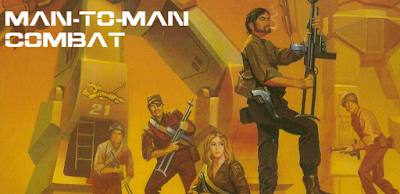Movement is overly detailed, with Movement Points (MP) based on action type—walking is 4 MP, dodging is 6, sprinting is 12. Terrain mostly halves movement. Aiming requires slow movement, dodging makes you harder to hit, and sprinters can’t shoot. Turning 60 degrees costs 1 MP. The Run skill boosts running and sprinting speed. Vehicles are mentioned but don’t seem fully integrated into this system.
The reaction phase gives everyone a free 60-degree turn, with the initiative winner turning first.
Ranged combat is a weapon skill check. Range penalties follow the familiar short (no penalty), medium (+2), and long (+4). A +4 penalty makes long shots barely worth attempting. Most fights will happen at close range—4-5 hexes (20-25 meters). Damage varies wildly: 2d6 for an auto-pistol, 5d6+6 for an SRM launcher. Burst fire sprays all adjacent hexes on a hit for 1d6 each. Double-barrel shotguns, as in many RPGs, feel absurdly strong doing 6d6 damage—why do designers do this? Stunners and tranq guns are highly effective, forcing a Body save or taking the target out of the fight. Additional penalties stack based on movement, cover, and target actions. Called shots are possible but punishing (+6 for a headshot). It looks tough to land hits with all these penalties. There’s a table for damaging ‘Mechs with small arms, but it’s clear you shouldn’t bother.
Armor helps, with flak vests absorbing damage to your torso and arms, flak suits protect everywhere but the tradeoff is halved movement - probably worth it.
Melee is possible if you didn’t run or sprint, though runners and sprinters can tackle for non-lethal damage. Melee attacks suffer penalties similar to ranged combat, but opting to make an “All-Out Attack” provides a bonus, making melee viable. Brawling damage scales with Body, making it the best option for strong characters. Grappling seems powerful, but I can’t tell if the grappler can actually deal damage once they've successfully grappled someone. Shields exist and allow you to make a knock-down melee attack, but they slow movement and lower accuracy, making them a bad choice.
If you manage to land a hit, damage is brutal. A d66 roll determines hit location. Damage capacity is Body x10, divided across body parts. If you had a body of 6 your torso would have the capacity to take 18 damage and your head 6. A limb at 0 becomes useless, while a head or torso at 0 forces a Body save or death. Any location reduced below 0, as well as rolling doubles on hit location means a critical injury—permanent wounds like a blinded eye or torn-off foot. Taking damage also forces a roll to stay conscious, with increasing difficulty the more you’re hit. At half health, you start bleeding out unless treated. It’s grim, WFRP-style brutal.
Man-to-man combat is intensely detailed—I've heard it called "meat-mech" as it seems to copy the Battletech combat rules. I think I could run this if I used tokens to record people's movement during the round - otherwise tracking all this stuff will be a nightmare.
I think I like the way combat works apart from all the modifiers and movement mode selection. A single lucky shot to the head will kill you while it might take 3 hits to the torso, 6 if you have a flak vest. I'd be willing to give it a go.


No comments:
Post a Comment